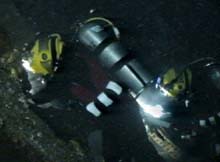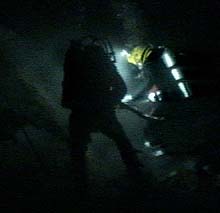
The ROV’s camera captures two Navy divers as they enter the Monitor’s hull, guided only by the small lights mounted on their helmets. U.S. Navy Photo. Click image for larger view.

Working on the Monitor at night, Navy divers often experience a surreal atmosphere. U.S. Navy Photo. Click image for larger view.
Night Shift on the D.B. Wotan
August 10, 2001
Jeff Johnston, Program Specialist
Monitor National Marine Sanctuary, NOAA
2001 marked the first year we conducted 24-hr diving operations in the Monitor National Marine Sanctuary. The challenges encountered during daylight hours became increasingly challenging at night.
During the Monitor 2001 Expedition, the day was divided into two 12-hr shifts, beginning at d 6 am and 6 pm. These shifts continually overlapped each other, as all shift leaders held "turnover" briefings at 5:30 am and pm to report on the work accomplished on the previous shift, and to assign tasks for the next. Frequently, tasks overlapped the shift change, so we often remained at the workstation to see the task through to completion or to assist the oncoming team.
Even though the Navy divers are fully accustomed to diving at night, in the darkness the Monitor took on a completely different atmosphere that was, at times, incredibly surreal. The divers' perspective was narrowed -- their view of the wreck was limited to the area that their small, helmet-mounted lights could illuminate. At times, the biggest challenge was just being able to locate a particular area of the work site, or even the wreck itself!
We did everything possible to ensure the dive was as productive as possible and that the collateral damage was kept to a minimum. On deck, prior to each dive, we did our best to brief the divers as thoroughly as possible. When possible, divers who were not familiar with the site were paired up with those who were. We used all the resources at our disposal to familiarize the divers with the project: A wreck model, engine model, drawings, video, photographs from previous dives, and the ever present dry-erase board.
Because of my familiarity with the wreck and the project, I was on station for all of the surface-supplied dives during my shift. I often guided the divers by watching the video from their helmet cameras and directing them via their helmets’ communication systems. Between surface-supplied dives, it was over to the SAT (saturation diving system) van to monitor their progress; then over to the remotely operated vehicle (ROV) to check out the overall progress made during the previous dives. The process then repeated itself, over and over again, throughout the night, seven days a week.
The majority of the brass and glass artifacts that we recovered were encountered during the night dives. While the darkness slowed some of the work at times, the divers’ helmet lights would often reflect off of shiny objects partially hidden under debris or buried in the silt.
The artificial light also brought out the incredible colors that are not seen in the ambient light during the day. At night, corals, anemones, and sea fans glow with a vibrant brilliance. The varieties of marine life on the wreck also change at night, as the nocturnal creatures emerge to feed and the smaller reef fish hide so as not to be fed upon. Even though we at the Monitor Sanctuary primarily view the wreck as a cultural resource, seeing the colorful life on the wreck -- especially at night -- reminds us that we also have a beautiful artificial reef here.
Sign up for the Ocean Explorer E-mail Update List.






















